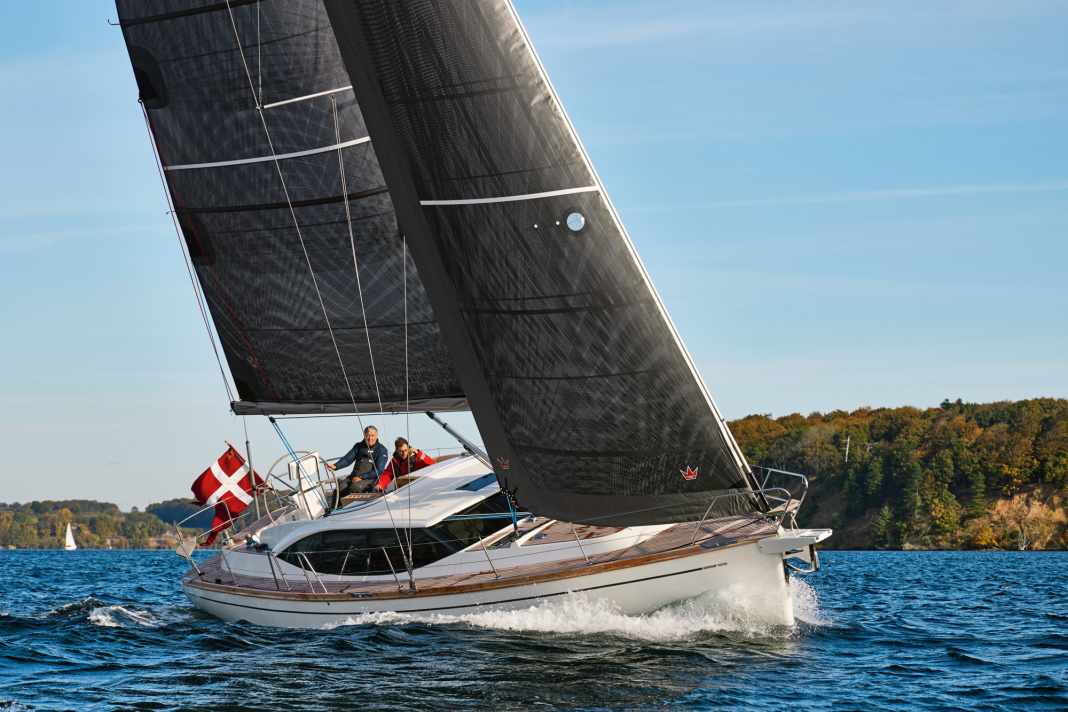





In this article:
The deck saloon boat ekes out an existence in a niche. Only a few shipyards dare to take on the demanding spatial concept, the aesthetic risk, the ambitious compromise between increasing weight and the desire for good sailing performance. Sirius from Lake Plön is one of them, as is the Hanse Group with its Moody brand, Wauquiez and Alubat (Ovni) from France, Scandi from Finland and Nordship from the Danish mainland, which was founded in 1987.
Mind you, we are talking about the deck saloon, yachts whose seating area in the saloon is positioned so that you can look out while seated and enjoy an almost all-round view. Other shipyards are on the move with only a higher superstructure for more light, but still with a low couch: Contest, Oyster, Elan (GT), Discovery/ Southerly, Bavaria (Vision).
Nordship, the ambitious small series shipyard
Nordship it is. Although the manufacturer, which merged with Faurby Yachts, only produces around twelve units per year, it is currently producing a firework display of new products: in autumn 2021, the ambitious Flagship 570 DS This was followed shortly afterwards by the 420 DS tested here and then a 500 DS. The programme also includes the 360 and the 380, which still have the old look with split windows.
The 420 DS is the smallest yacht in the revised range and can be recognised by the almost almond-shaped superstructure panels, which look as if they have been cast from a single mould, but of course cannot do without an internal load-bearing structure. The hull of the boat is based on the 40 and therefore still has rather conservative, streamlined lines without chines, bevelled edges or an overly wide stern.
The superstructure may look bulky, but it is beautifully integrated into the rest of the deck, which has been completely redesigned. The canopy flows smoothly into high cockpit coamings that end at the height of the individual steering column. The cockpit itself consists of a large section, which is free of any controls, and the working area with wheel and sheet winches, which is separated by a bridge deck. This is also where the halyards and outhauls end, which are led aft through tubes. The gennaker winches are positioned on the surrounding bench for the helmsman, which also provides some storage space.
The boat sails and behaves more agile on the wheel than it is capable of due to its high superstructure
Fully single-handed sailing fun
The Technora Black mainsail from Elvstrøm grows electrically into the autumn sky off Middelfart on the Little Belt. It could also be done by hand, but the friction in the tubes cannot be ignored. The self-tacking jib wraps around Facnor's flatfurler from the forestay. And off we go. Deckssalon can also perform and, perhaps almost more importantly, deliver fun. It is a pure joy to direct the Nordship to the windward edge and let it dance away. The track is quickly found and, thanks to the self-tacking jib, it is great fun for the whole family to turn up even in the narrow waters between Fanø and Fynen, if they know how to keep themselves occupied: because the boat is perfectly suitable for single-handed sailing.
The mainsheet is within the helmsman's direct reach on one side, as is the traveller, which could, however, be longer. If a co-sailor wants to help out with a winch, he needs particularly thick and long arms if he wants to do this from the tourist cockpit at the front. He will want to climb aft and do his job from the helmsman's cockpit.
No matter. The pleasure of the wheel (which could be slightly larger) is even greater thanks to a good height with possible turning angles of less than 90 degrees, plus values beyond the seven-knot mark. The rudder pressure is well-dosed and provides feedback, the wheel works directly enough with one and a half turns from stop to stop and favours fatigue-free steering while seated on the wide coamings, from where the view to the front is unobstructed.
Naturally, things get off to an even better start, quickly reaching and exceeding eight knots. We still wish we had deck eyes for the outer sheet, so that the narrow, upwind self-tacking jib could also be forced to perform upwind. Never mind. The boat sails fast, high and extraordinarily stiff, even in pushers.
Typical deck saloon: the view is phenomenal
There are no particular problems under engine, not even when manoeuvring. What's more, Nordship not only offers various bow thrusters, but is also happy to install a stern thruster in the skeg, which are useful options.
It is slowly getting shady, a good opportunity to try out the comfort qualities of the deckhouse. The view from the sofa through the up to 50-centimetre-high windows is phenomenal, the room is bright and inviting, so we can continue. The boat could not only be kept on course with the remote control of the autopilot, but could even be turned around with it, see the self-tacking jib above. A proper inside steering position with wheel is therefore superfluous.
However, the navigation table is positioned on the saloon floor, which is around 36 centimetres lower than the seating area. Anyone working there cannot see out. This changes when the marinised rolling office chair, which is fixed by an articulated rod, is raised significantly so that it can also be used at the salon table. But then the table is difficult to reach.
The deck saloon literally takes the concept of a harbour cinema to a new level. But there is one more thing: the 24-millimetre-thick thermally insulated safety glass panes are somewhat darkened, but in the evening with the lights on, the company at the 1.20-metre-long and 85-centimetre-wide table itself becomes a matter of opinion. In this case, blinds or a trip to the so-called evening saloon between the companionway and the aft cabin, where there is room for three people, can help. The shipyard is also happy to realise any other possible use there, from a bunk bed to an office.
The owner's realm lies aft, central and spacious. Only the 1.60 metre high door and the 1.76 metre clear space under the bridge deck on the way from one side to the other in the aft cabin require a brief humble attitude.
Spacious technical room for equipment nerds
And then, after the deck saloon and the evening saloon, comes the third special feature, the playground for the owner couple with an affinity for tinkering and materials. The technical room is located where a second wet room could also be installed - a haven of maximum enjoyment for every equipment nerd and tinkerer. There is space for storage boxes, toolboxes and equipment on two deep, 1.60 metre long shelves. There is space for the inflatable boat, outboard motor, folding bikes and additional sails, with access from above via the locker lid. Sheets, lines and fenders hang there, a vice could be installed and battery chargers could be permanently attached - great!
In addition, installations such as the heating system, electrical supply components, filters and seacocks are easily accessible there and in the neighbouring area below the seating area.
Another unusual yacht-building feature is the positioning of the galley. It is lowered in front of the navigation area. The cook works there, somewhat separated from the saloon seating area and without a view of the harbour or the anchorage, which he doesn't have to like. He can at least look forward to plenty of storage space, which is also available in the deep bilge, which is easy to reach thanks to hinged floorboards with handles. If required, an icebox can be added to the standard household refrigerator, ventilation options are available and there is also space for small items. However, higher rocker rails would make the galley more seaworthy. The cooker gimbal could also do with more of this feature: On the starboard bow, the stove already kicks in at 17 degrees; it should be a little more.
Expensive, but lavishly equipped and customisable
The washroom is accessed from the passageway and is surprisingly spacious. There is space for a large electric toilet and a separate shower compartment with a standing height of 1.94 metres and a large floor area of 70 x 75 centimetres. The space can also be used as a drying cabinet for oilskins thanks to the air outlet of the standard heater located here.
The guest cabin is located in the foredeck and the berth is quite large. The walls are fitted with classic panelling that perfectly matches the look below deck. This is because it has a traditional design to some extent, but is de-muffled. The standard mahogany has a pore-filling matt varnish and is manufactured in the best Scandinavian boatbuilding style. Joints are clean, edges are broken, joints are small - eyes and hands are delighted. Also nice: instead of an inner shell, the headliner is clad with imitation leather and decorative wooden mouldings.
The Nordship 420 DS is a strong competitor in the small market of deck saloon yachts. The price is high, but hardly gets any higher when the sensible comfort features are ticked; the ship is superbly equipped. And it is also due to the small number of units, the high quality craftsmanship and the potential for customisation. Thomas Dan Hougaard, co-owner alongside founder and house designer Lars Buchwald: "Basically, the customer can have everything. We lowered the floor on the test boat because the owner is so tall. A sailing load at the front and a smaller cabin is just as possible as a larger galley, a single shower or two cabins aft."
Technical data Nordship 420 DS
- Designer:Lars Buchwald/Arne Borghegen
- CE design category: A
- Torso length:12,20 m
- Total length: 12,80 m
- Waterline length: 10,80 m
- Width:4,00 m
- Draught/alternative: 1.9/div. m
- Mast height above waterline: 20,20 m
- Theoretical torso speed: 8.0 kn
- Weight:10,5 t
- Ballast/proportion:3,6 t/34 %
- Mainsail:50,0 m2
- Self-tacking jib:34,0 m²
- Machine (Volvo):44 kW/60 hp
- Fuel tank (stainless steel):375 l
- Fresh water tanks (2, stainless steel):185 litres each
- Holding tank (plastic):110 l
- Batteries: 3x 100 Ah + 1x starter
Sailing performance
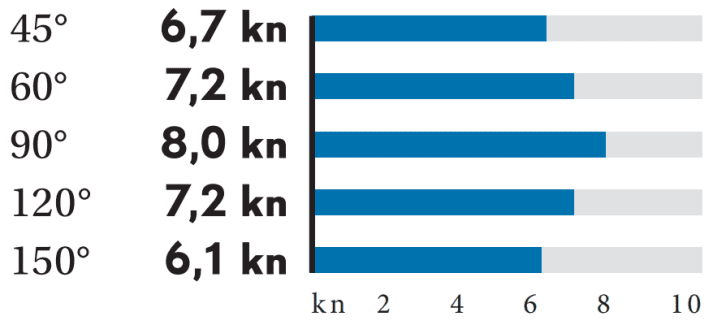
without drift/current; wind speed: 12 to 18 kn (4-5 Bft), wave height: smooth water
Potential STZ1 = 4.2

The rather low value is calculated with the self-tacking jib, which was sufficient for good speed during the test
Sound pressure
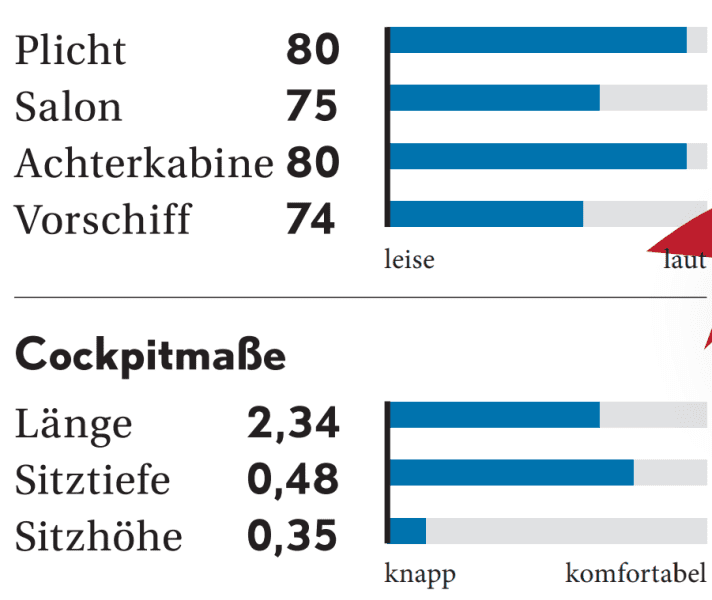
In dB(A), measured at cruising speed (80 % of maximum speed): 7.0 kn, 2,200 min -1
Hull and deck construction
Sandwich construction with foam core and vinyl ester resins using the hand lay-up method. Full laminate under water. Bulkheads laminated. Deck glued and screwed
Hull shape
The bulkhead is predominantly round, the lines are straight, there are no chines, and the stern is strongly constricted
Keel and rudder
The profiles are long in the chord, which stands for course stability. The bomb is made of lead
Rig
The sail plan on the 20.20 metre Seldén rig is stretched. The self-tacking jib is the standard sail plan
Glazing
The panes, which are up to 50 centimetres high, are made of 24 mm thick insulating and tinted safety glass
Motor and gearbox
With the 60 hp Volvo Penta D2-60 and a three-bladed folding propeller on the saildrive, the boat is well motorised and can reach over seven knots at cruising speed
Sail
Dacron sails are included in the standard price. Elvstrøm's Epex cloths with one-sided tafetta armouring were used on the test boat and stood up excellently
Fittings
Four Andersen 46 winches make sheeting a pleasure. Worth mentioning is the Facnor webbing reefing system, which is only flat and mounted on ball bearings
Shipyard and distribution
Nordship Yachts, 6640 Lunderskov, Denmark; www.nordship.dk
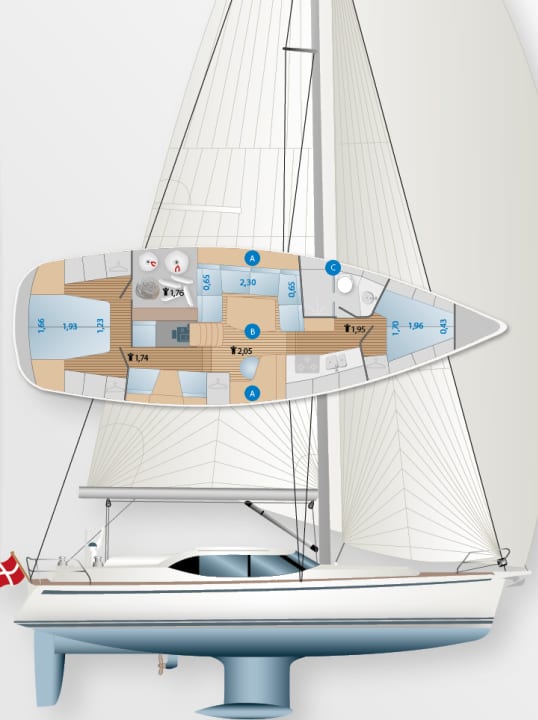
In a previous version, incorrect interior heights and berth dimensions were indicated in the drawing. We apologise for this and would like to thank our attentive readers for their comments.
Equipment and prices Nordship 420 DS
Antifouling, sprayhood, heating, crockery for six people, everything already included. All that's missing is a wind gauge and autopilot - and the tiresome clear-sailing handover
- Base price ex shipyard:622.263 €
- Standard equipment included:Engine, main and genoa, sailcloth, sheets, railing, anchor with chain, fenders/mooring lines, navigation lights, battery, compass, cushions, galley/cooker, bilge pump, WC, fire extinguisher, electric cooler, holding tank with suction, antifouling
For an extra charge:
- clear sailing handover: 2.960 €
- Price ready to sail: 625.223 €
- Guarantee/against osmosis:2/5 years
Surcharges for comfort equipment
- Line-adjustable hole points: n. a.
- Traveller with line guide: inclusive
- Electric windlass: inclusive
- Tube kicker: inclusive
- Backstay tensioner: inclusive
- Jumping cleats: inclusive
- Sprayhood: inclusive
- Teak in the cockpit:inclusive
- VHF radio: 1.940 €
- Log and echo sounder: inclusive
- Wind measuring system: 1.875 €
- Autopilot: 6.762 €
- Charger: inclusive
- Electrical package: inclusive
- Shore connection with RCD: inclusive
- 230 volt socket (one): inclusive
- 12-volt socket in the sat nav: inclusive
- Heating: inclusive
- Pressurised water system: inclusive
- Hot water boiler: inclusive
- Shower WC room: included
- Cockpit shower: 737 €
Comfort price:636.537€
Included in the price:
GRP bowsprit with ladder, teak coaming, jib halyard winch on mast, stainless steel spring cleats, folding propeller, electric toilet, 300 Ah battery capacity, 115 Ah alternator
YACHT review Nordship 420 DS
The Nordship 420 DS leaves nothing to be desired in terms of sailing, is built and equipped to a high standard, offers plenty of living and storage space, is suitable for use all year round thanks to the deck saloon, and the customer has a wide range of options. A successful and special boat
Design and concept
- + Consistent deck saloon
- + Highly customisable
- + Solid and durable construction
Sailing performance and trim
- + Easily retrievable good speed
- + Agile at the helm
- + Stiff and easy to control
- - Jib winches difficult to operate for crew
Living and finishing quality
- + Outstanding finish
- + Exemplary installations
- + An incredible amount of storage space
- + Optional sail load
Equipment and technology
- + High-quality equipment
- + Separate technical room!
- - Cooker strikes starboard bow at 17 degrees
The competition of the Nordship 420 DS
Moody DS 41
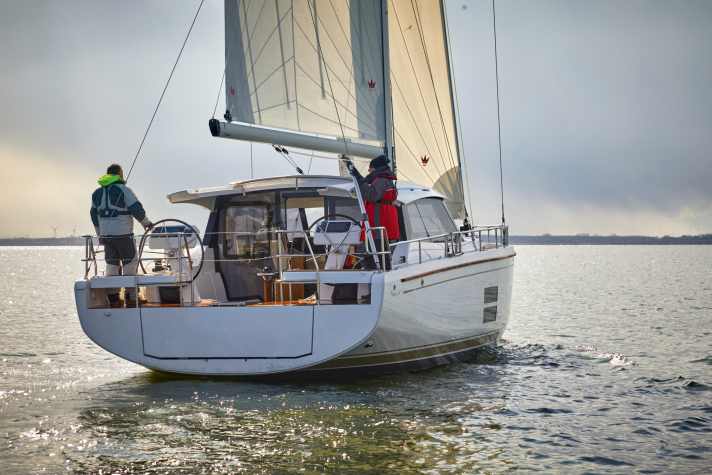
Deck saloon with inside steering position at cockpit floor level with raised steering positions on deck. No aft cabin.
Hull length 11.99 m; width 4.20 m; weight 11.6 tonnes; from 474,810 euros
Scandi 42
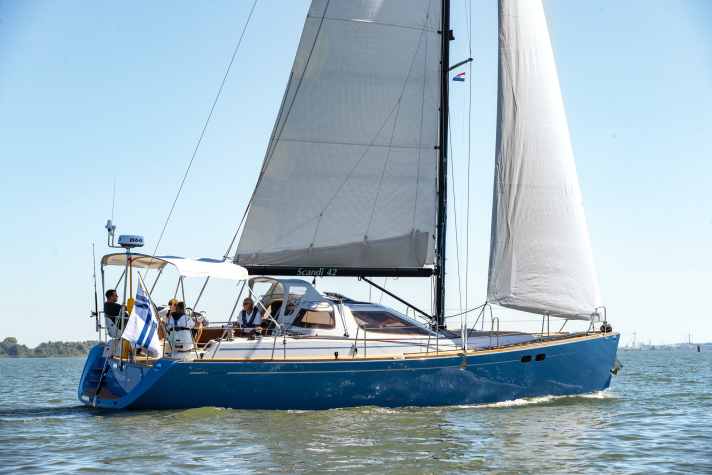
Finnish deck saloon yacht with short superstructure and raised helm stations in the aft cockpit as well as a high-lying inside helm station.
Hull length 12.80 m; width 4.06 m; weight 7.5 tonnes; from 475,040 euros
YACHT test: coming soon
Sirius 40
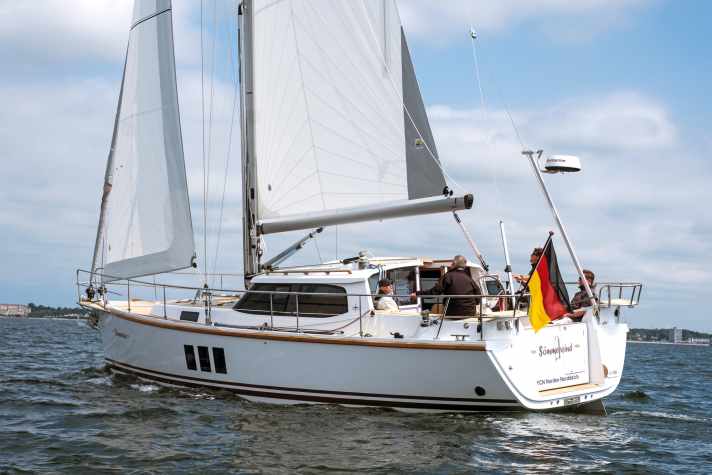
The helm position, cockpit floor and seating area are at the same height. Inside steering position slightly raised. Third cabin under the seating area.
Hull length 11.99 m; width 4.00 m; weight 11.0 tonnes; from 730,000 euros

